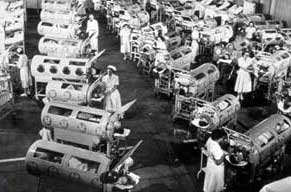 |

© WHO/21618/March
of Dimes, Birth Defects Foundation |
 |

Five
to 10 per cent of polio victims can suffer paralysis of their breathing
muscles, threatening death by asphyxiation. To guard against this,
a breathing apparatus called the iron lung was developed in the 1930s.
Iron lungs became a common sight in North American hospital wards,
like this one in Los Angeles, through the 1950s.
  |
 |





